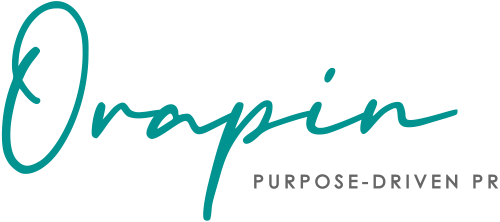
When an earned media opportunity arises, make sure your spokesperson has what they need to succeed
It’s happened. The moment you’ve been wishing for – a reporter from an influential national media outlet has responded to your pitch and wants to interview your CEO. Queue the celebration! Maybe you’ve been pitching your story proactively, or perhaps the reporter called you out of the blue. Regardless of how the interview request came about, it is time to get to work and start prepping your spokesperson to make the most of this hard-earned opportunity.
The spokesperson for most purpose-driven companies or nonprofits will be the CEO or executive director. Whether or not they “like” doing interviews (some do, some don’t!), it is an essential part of their job to serve as the spokesperson for the organization. As the spokesperson, they must be able to convey your message/your cause/your call to action with clarity throughout the interview. The best way to ensure that happens is to help them adequately prepare! An interview is a chance to get visibility for your organization that could lead to new clients, donors, and supporters – don’t let the opportunity turn into a flop. Preparation will help ensure the interview is both a positive experience for your executive and a win for your organization.
How do you prepare for a successful media interview?
We cannot control what the spokesperson says during the interview, as much as we’d like to sometimes! But, as PR practitioners, we can do everything in our power to ensure the spokesperson is well-prepared, comfortable, and has all the tools they need to succeed. Here are a few ways to prepare your spokesperson for their next interview.
✔️ Provide a press profile before the interview
This one-sheeter is a cheat sheet for the executive, providing a comprehensive overview of the person interviewing them. Knowing who is on the other end of the line helps create a sense of comfort and provides insight into the types of questions they might ask and any outside interests or moments for connection and rapport (like the fact they just got a new puppy or traveled internationally). The press profile should include the following elements:
- Name, title, media outlet, and headshot: Include a link so your spokesperson can easily access the outlet’s website.
- Interview date/time/story focus: Include information on when/where the interview will occur and the story’s focus.
- Links to social media handles: Provide links to the reporter’s LinkedIn, Twitter/X, Instagram, or other relevant social media handles so your spokesperson can click through and get a sense of their voice and interests.
- Brief bio: A press bio should be a few sentences and include information on their beat, current/past reporting focus areas, and other interesting professional or personal information. Sometimes the reporter will indicate that they “love skiing” or “have three corgis” – if this information is relevant to your spokesperson, i.e., they also have a pet corgi, then include it as it can be an excellent way to build a connection.
- Links to past articles/stories: Provide links to past articles or story clips so your spokesperson can read/view examples of their work and understand their reporting style and tone.
✔️ Create talking points and include a call to action
As you coordinate interview scheduling with the reporter, always ask for information on the focus/angle of the story. This valuable information will help guide the talking points you provide for your executive. Don’t be timid about asking for this information; at the end of the day, this information will help your executive prepare for the interview, allowing them to share relevant stats and stories easily, which will help the reporter out. Most reporters will give you a basic outline of their story angle at a minimum, and some will go so far as to provide the interview questions.
Use the information provided to create talking points for the executive. Help them pull relevant data points to support their narrative when applicable. The more detail and information you can give your executive, the more comfortable they will feel during the interview. For purpose-driven organizations, make sure the talking points include a call to action! It is great to tell your impact story, but make sure your executive provides information on how people can support your cause!
✔️ Offer coaching for practicing or refining interview tips and techniques
Some executives do a lot of interviews and are highly articulate when they go on-mic. Others have less experience. For those with less interview experience, consider media training to go over “do’s and don’ts” for a successful interview. Ensuring your spokesperson knows at least a few basic interview tricks for success will help both of you feel more confident.
✔️ Staff the interview
We rarely send an executive into an interview situation on their own. Whether the spokesperson is going on camera or doing an interview via Zoom or phone, it is a good idea to be present/on-site or online as a backup but always be on mute and off camera. In an ideal scenario, your spokesperson nails the interview and you have just been present for moral support. Even in this situation, reporters often ask for follow-up items such as supporting images, stats, data, or a secondary interview. As the PR person, you want to be there to take note of these requests and build your rapport with the reporter.
Occasionally, there may be a break in the interview or an opportunity to coach your spokesperson. Between segments or on a phone call, a reporter or the interviewee may want to know if they are missing information or key talking points. This moment is an opportunity to add value by providing gentle reminders such as “Don’t forget to mention the impact that our behavioral health programming had for XYZ community…”
Finally, by auditing the interview, you gain valuable insight into how well your spokesperson conducts it. Do they need additional practice or coaching? Are there areas for improvement? Could they do better at storytelling around your mission?
✔️ Follow up with your executive and the reporter after the interview
After the interview do a check-in with your executive. At a minimum, they will want to know when the story will come out. In addition, do a temperature reading with the spokesperson. Did they feel it went well? Did they feel they were able to get all their talking points across? Did they feel nervous/comfortable/energized? Each of these data points will help you and your spokesperson prepare for the next opportunity.
Further, it is always a good idea to follow up with the reporter after the interview to thank them and ask if they have any additional questions or need images or additional supporting materials. This follow-up email is also a good opportunity to share additional talking points the executive may have missed.
What defines an earned media win?
A PR win for a purpose-driven organization is a story that clearly conveys your cause, your impact, and your call to action. As the person coordinating the interview opportunity, a win for you is a well-prepared spokesperson who you feel confident putting on the phone with a reporter. Preparation is your best tool to ensure everything goes smoothly! At the end of the day, you hope your executive achieves the following:
- They are relaxed, approachable, and create a connection with the reporter
- They clearly communicate key messages
- They include a call to action
- The resulting media piece tells your organization’s story and creates a connection with your audience
Following the steps outlined above should help you and your spokesperson put your collective best foot forward. And if it doesn’t go perfectly, you have a teaching and training moment for next time. We are all works in progress! But taking the time to prepare your spokesperson will certainly yield better results and set them up for interview success.

Diana Crawford is a seasoned public relations consultant with more than 15 years of agency, consulting, and in-house experience. She joined Orapin in 2013 and manages account services and client communications strategy development. She has worked across a variety of industries and has expertise with professional services, food/alcohol, health and wellness, lifestyle, sports, education, tech, and non-profit organizations.
